It's Wednesday April 24, 2024
News From The Village Updated Almost Daily
September 9, 2011
The Bay River reached historically high water levels during Hurricane Irene. Some residents reported it was a foot and a half higher than in 2003’s Isabel. Isabel’s surge was so high that many thought it wouldn’t be repeated. That was not the case.As was shown in Florence, you didn’t have to live at the water’s edge to be flooded by Irene. Away from the waterfront properties, many homes along the Florence-Whortsonsville Road , especially in Florence, got water in them.
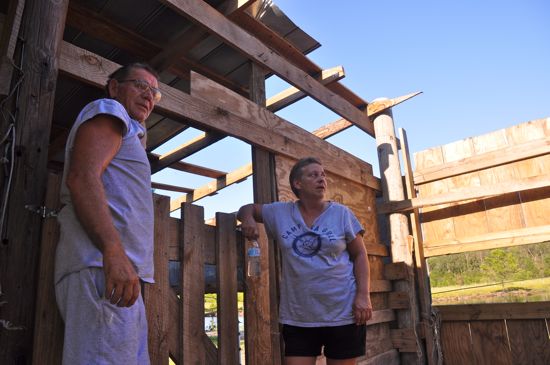 Ted and Pat Morris a week after Hurricane Irene. During part of the hurricane, Ted perched on the wooden slat behind him, watching the historically high waters cover the farm. Part of the roof was peeled away by the winds, too.
Ted and Pat Morris a week after Hurricane Irene. During part of the hurricane, Ted perched on the wooden slat behind him, watching the historically high waters cover the farm. Part of the roof was peeled away by the winds, too.For one couple the losses were not only in their house — they think it’s totaled — but in their barnyard, too. Pat and Ted Morris have a hobby farm just down the road from Days Corner. They have a donkey, a half dozen horses. Going in to Hurricane Irene they also had Pat’s garden and 40 hens and more than 20 cattle as well.
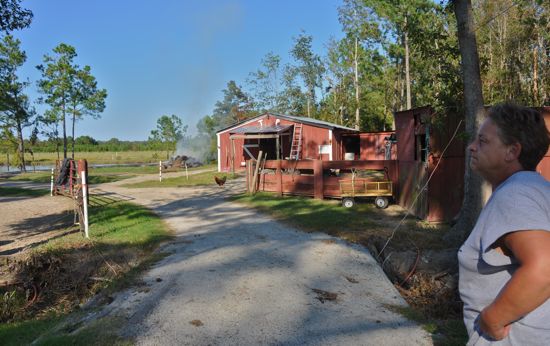 Pat Morris. Waters during Irene were chest high. Horses in the stables in the background survived. Part of the cow herd disappeared. The rest were sold, for want of hay and feed, in the week after Irene.
Pat Morris. Waters during Irene were chest high. Horses in the stables in the background survived. Part of the cow herd disappeared. The rest were sold, for want of hay and feed, in the week after Irene.When Hurricane Irene hit, Pat was at her nursing job in James City. Ted kept her updated as the waters seeped in to their yard and then rose to Hurricane Isabel’s level. Then they rose more than anyone had seen there before.
The water got up to the screen of their porch door and poured in to the house. Ted used a canoe – flipping it more than once – to get across the yard to check on his animals. The horses, which can swim, were fine, up to their necks in water in their stalls. The cows did not fare as well.
On one canoe outing, Ted returned to the house to find that his generator, thought to be on a high spot in the backyard, flooded. Ditto his garage and the tools inside.
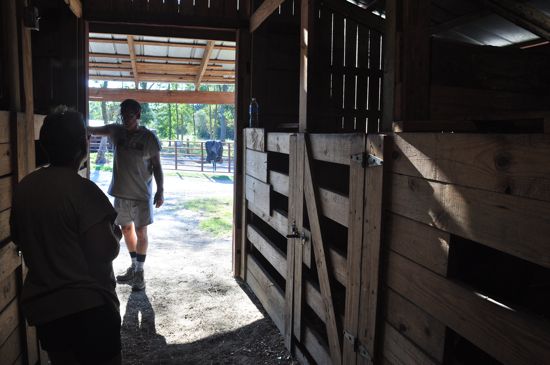 The stables had about 4 feet of water in them during Irene., putting the six horses neck deep. The horses survived. A quarter of the cattle herd did not and disappeared in the flood waters.
The stables had about 4 feet of water in them during Irene., putting the six horses neck deep. The horses survived. A quarter of the cattle herd did not and disappeared in the flood waters.Ted’s truck had also been parked on high ground, at the far end of the farm, a spot that had always been high and dry. On one foray out, Ted found that it wasn’t high enough – Irene’s surge waters flooded the truck. The retired contractor fought his way back through the rising waters, holding on tight to the metal fencing of a horse corral before walking/swimming to a cow shed.
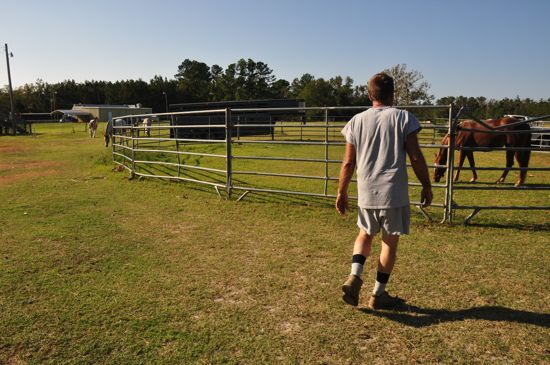 At Ted Morris’ farm. The horse corral that gave him a handhold in the storm. All six of his wife’s horses survived too. In the background, the back of the store at Days Corner.
At Ted Morris’ farm. The horse corral that gave him a handhold in the storm. All six of his wife’s horses survived too. In the background, the back of the store at Days Corner.That shed, says Ted Morris, is where he rode out the worst hours of Irene. The cows were gone. Perched on a cross board, above the water, he says he could look through an opening in a wall and watch the ocean that was covering his farm. Part of the tin roof of his shelter had peeled off in a long strip, flying in to the upper reaches of a tree. To protect himself from flying debris, Ted says, he covered his head with a bucket.
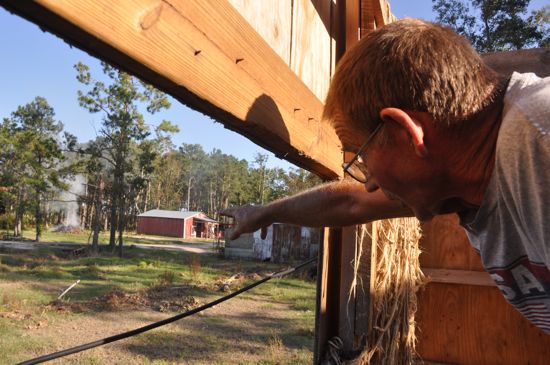 A vista on a hurricane. Ted Morris looking through the hole in the wall where he could watch Hurricane Irene cover the farmyard. A week later, smoke rose from the ruined bales of hay that they were burning.
A vista on a hurricane. Ted Morris looking through the hole in the wall where he could watch Hurricane Irene cover the farmyard. A week later, smoke rose from the ruined bales of hay that they were burning.[page]
Meanwhile, Pat began to drive from New Bern toward Florence, wanting to help, but the roads were becoming more and more blocked by downed trees and wires. She spoke with her husband on the phone a lot, asking at one point how he managed to keep his cell phone dry. He told her he’d found a coffee can that he used for doling out feed and that he kept the cell phone in there, under a lid.
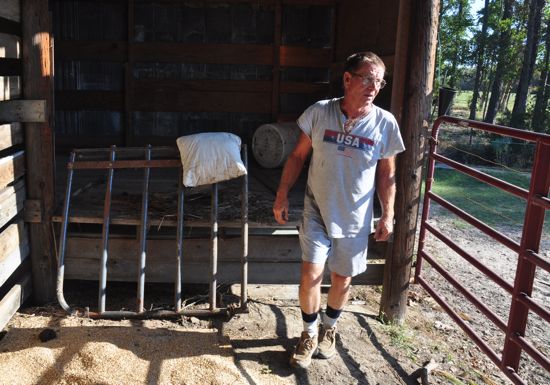 Ted Morris. He spent a while in the cow shed during the height of Hurricane Irene, perched on a fence to be above the surge waters. Behind him is one of the buckets he put over his head to protect himself from Irene’s flying debris.
Ted Morris. He spent a while in the cow shed during the height of Hurricane Irene, perched on a fence to be above the surge waters. Behind him is one of the buckets he put over his head to protect himself from Irene’s flying debris.When the waters ebbed hours later, a half dozen cows were gone. Pat says she thinks that in the unexpectedly high surge, they washed down the creeks and out in to the Sound. About 15 cows were corralled back to the Morris’ farm. Ted had hoped to breed them and have calves next winter, but without proper feed — hay and feed were waterlogged — he sold them instead. He says the price he got was low, because the drought in Texas has caused a glut of cows for sale.
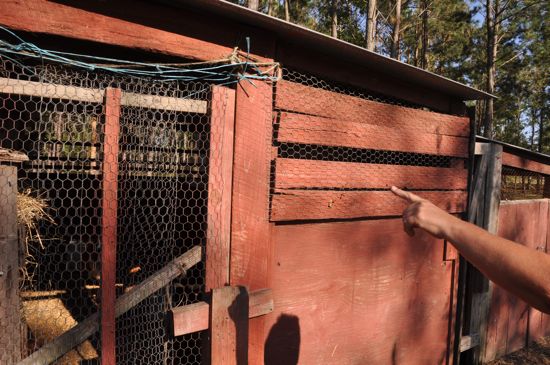 Pat Morris points to the chicken coop where waters rose and where most of the hens flocked to higher perches. More than a dozen hens however, died in the hurricane which put at least three feet of water in the coop.
Pat Morris points to the chicken coop where waters rose and where most of the hens flocked to higher perches. More than a dozen hens however, died in the hurricane which put at least three feet of water in the coop.As for the chickens, more than a dozen drowned or disappeared. But most, says Pat figured out a way to fly to a higher perch in their coop. They were back to laying eggs within the week.
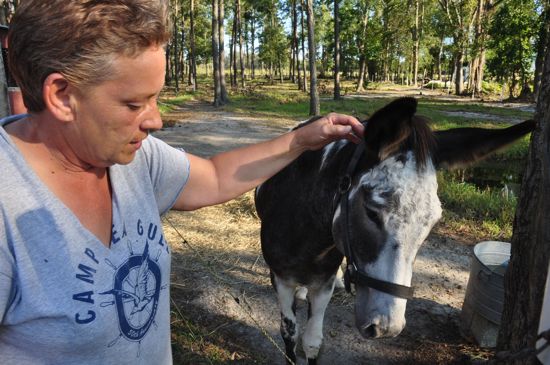 Pat Morris and her donkey, B-Bob (short for Billy Bob) He survived Irene, though hasn’t been braying as much. Pat says he misses the cows, some of whom disappeared in the storm. The rest of the cows were sold.
Pat Morris and her donkey, B-Bob (short for Billy Bob) He survived Irene, though hasn’t been braying as much. Pat says he misses the cows, some of whom disappeared in the storm. The rest of the cows were sold.A week after Irene, when we visited, Pat and Ted were burning ruined bales of hay, waiting on calls and visits from insurance adjusters – and learning that changes in insurance policies in recent years left them with less coverage than they thought they had.
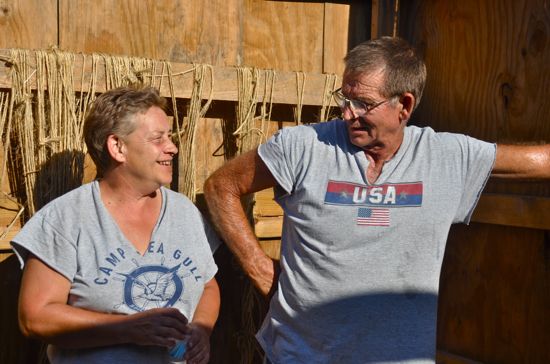 Pat and Ted Morris in the shed where he rode out part of Hurricane Irene.
Pat and Ted Morris in the shed where he rode out part of Hurricane Irene.They have those chickens, and the donkey — B-Bob – and the horses. A week after Irene, they’d also gotten a delivery of feed and dry hay from an equine relief organization. The Morrises hope to rebuild their home and get the garden going again. And maybe someday, raise some more cows.
Ahead, more from Florence, Paradise Shores and Whortonsville
[page]
Elsewhere in Florence and along the Florence-Whortonsville Road: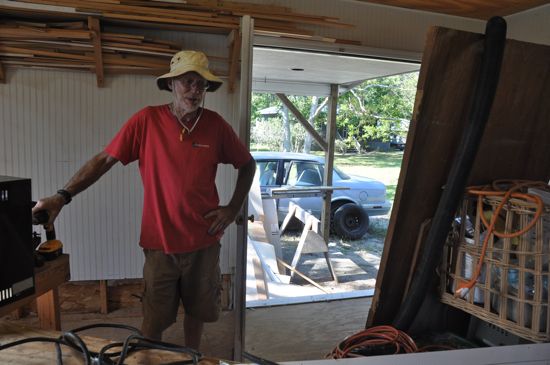 Tim Balfour in a workshop that was built above the the benchmark high set by Hurricane Isabel in 2003. It wasn’t enough. Irene came in a foot and a half higher than in his yard, and flooded the workshop, ruining tools. Cars the family parked on the hill outside the workshop flooded as well.
Tim Balfour in a workshop that was built above the the benchmark high set by Hurricane Isabel in 2003. It wasn’t enough. Irene came in a foot and a half higher than in his yard, and flooded the workshop, ruining tools. Cars the family parked on the hill outside the workshop flooded as well.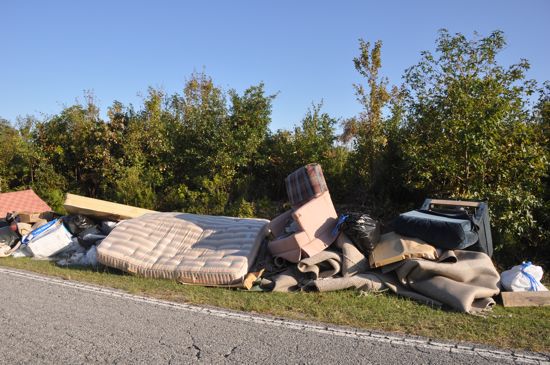 A common sight along the loop of the Florence Road post-Irene.
A common sight along the loop of the Florence Road post-Irene.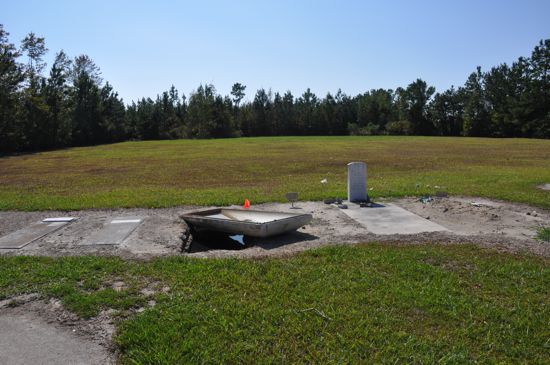 In Florence, a grave where a man was interred 17 years ago, opened up in Hurricane Irene. The casket floated into a backyard nearby. The family gathered there a few days after Irene and held a ceremony and said a blessing. The casket was to be re-interred.
In Florence, a grave where a man was interred 17 years ago, opened up in Hurricane Irene. The casket floated into a backyard nearby. The family gathered there a few days after Irene and held a ceremony and said a blessing. The casket was to be re-interred.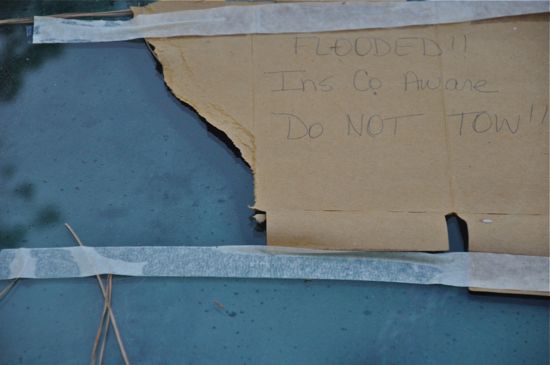 On one of two cars parked near what was thought to be high enough ground at Bay Shore Road and Florence-Whortonsville Road.
On one of two cars parked near what was thought to be high enough ground at Bay Shore Road and Florence-Whortonsville Road.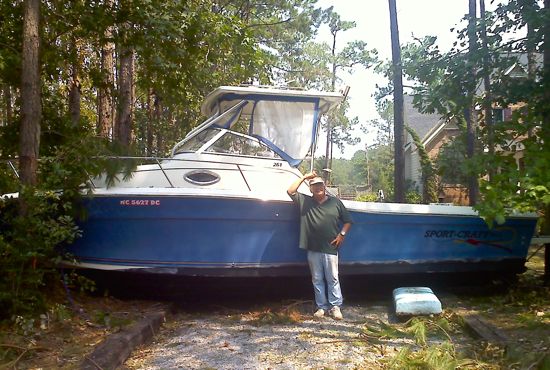 Ed Braun sent this photo of the boat that wound up in his driveway after the hurricane. “This is a picture of my neighbor, John Mitchell’s boat, (he is scratching his head), across my driveway. Boat came off its lift, floated up to Bay Shores Rd and made a right hand turn down our drive.” (Ed Braun photo)
Ed Braun sent this photo of the boat that wound up in his driveway after the hurricane. “This is a picture of my neighbor, John Mitchell’s boat, (he is scratching his head), across my driveway. Boat came off its lift, floated up to Bay Shores Rd and made a right hand turn down our drive.” (Ed Braun photo)Ahead, Irene at Paradise Shores:
[page]
Just a few miles down the road, between Florence and Whortonsville is Paradise Shores Road. Take it to its end and you are on Broad Creek, just across from River Dunes. Near the end of the road is Paradise Cove Marina.
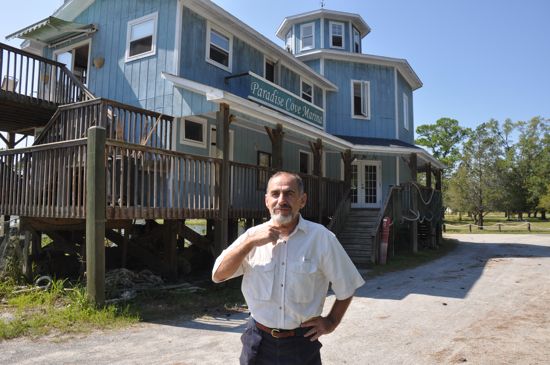 Paul Del Rio in front of Paradise Cove Marina. Water in the parking lot during Irene was, as he gestures, up to his chin.
Paul Del Rio in front of Paradise Cove Marina. Water in the parking lot during Irene was, as he gestures, up to his chin.The bar at the marina has been closed this season as its owner, Paul Del Rio works as a captain, but he was at home for the hurricane. The bar was high and dry, but many of the neighboring homes and vacation houses were not. Paul provided a photo taken during the height of Irene:
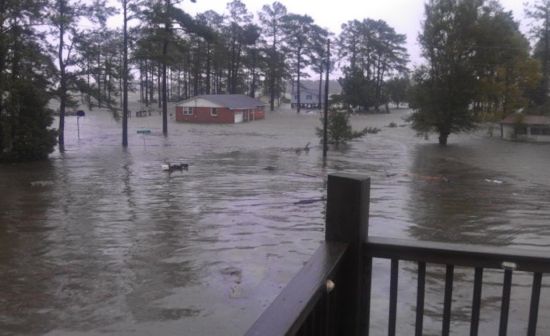 Paradise Shores Road as seen from the upper deck of the Paradise Cove Marina building during Hurricane Irene. (Paul Del Rio photo.).
Paradise Shores Road as seen from the upper deck of the Paradise Cove Marina building during Hurricane Irene. (Paul Del Rio photo.).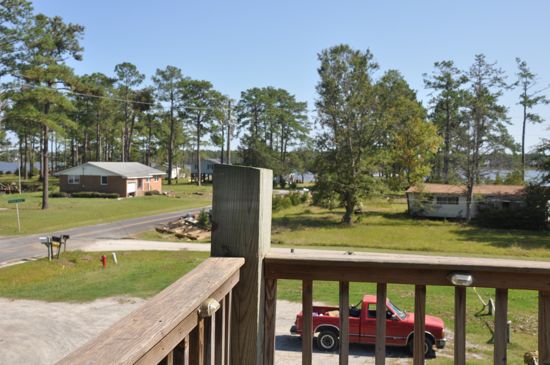 Same view a week later, when drier conditions prevailed.
Same view a week later, when drier conditions prevailed.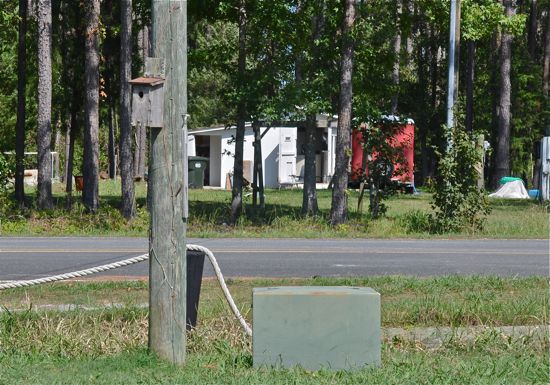 Another indicator of Irene’s storm surge was the birdhouse on a utility pole in the Paradise Cove Marina parking lot. Water got to the base of the birdhouse. While that presumably gave birds a refuge, the structures in the background would have flooded.
Another indicator of Irene’s storm surge was the birdhouse on a utility pole in the Paradise Cove Marina parking lot. Water got to the base of the birdhouse. While that presumably gave birds a refuge, the structures in the background would have flooded.[page]
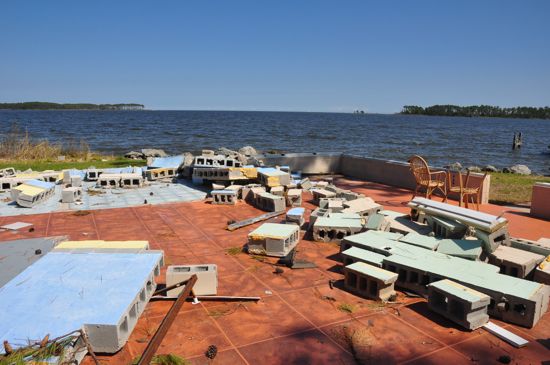 Paradise Shores is near where the Pamlico Sound enters Broad Creek. The properties there took the full brunt of the storm. The sides of this building are no more…. .
Paradise Shores is near where the Pamlico Sound enters Broad Creek. The properties there took the full brunt of the storm. The sides of this building are no more…. .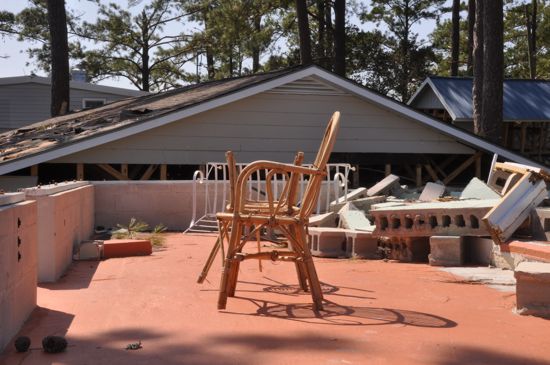 … and its roof was pushed by wind and water toward the property next door.
… and its roof was pushed by wind and water toward the property next door.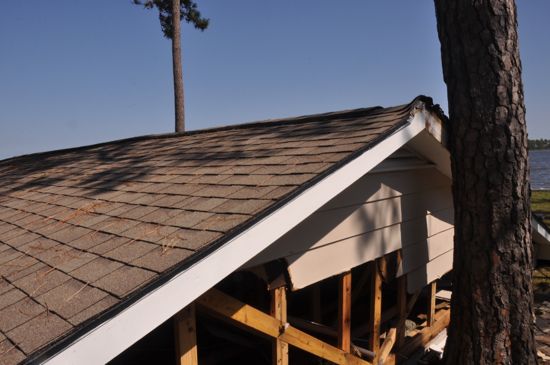 The runaway roof was stopped by two pine trees, one of which is shown here. Jill Bright says those trees likely saved her in-law’s vacation home from being pushed aside by that roof. Her in-laws home did flood, however, as did many in the Paradise Shores area.
The runaway roof was stopped by two pine trees, one of which is shown here. Jill Bright says those trees likely saved her in-law’s vacation home from being pushed aside by that roof. Her in-laws home did flood, however, as did many in the Paradise Shores area.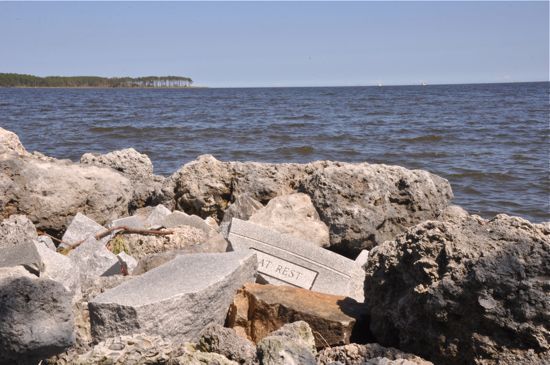 While marl was hurled on to the lawn, pieces of denser granite stayed in the rip-rap.
While marl was hurled on to the lawn, pieces of denser granite stayed in the rip-rap.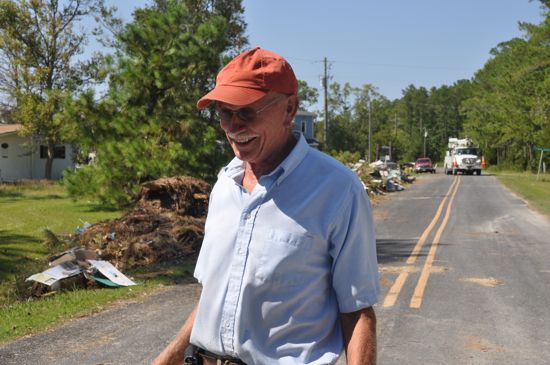 DL White says the living area of his home in Paradise Shores got thru okay but the water got high underneath. In the years since Hurricane Isabel put 42 inches of water under his home, DL says he often commented that it could never get higher. Then he says, Irene brought 48 inches. Asked if he thought this was the highest it would ever get, he said, “This time I“m not saying anything.”
DL White says the living area of his home in Paradise Shores got thru okay but the water got high underneath. In the years since Hurricane Isabel put 42 inches of water under his home, DL says he often commented that it could never get higher. Then he says, Irene brought 48 inches. Asked if he thought this was the highest it would ever get, he said, “This time I“m not saying anything.”[page]
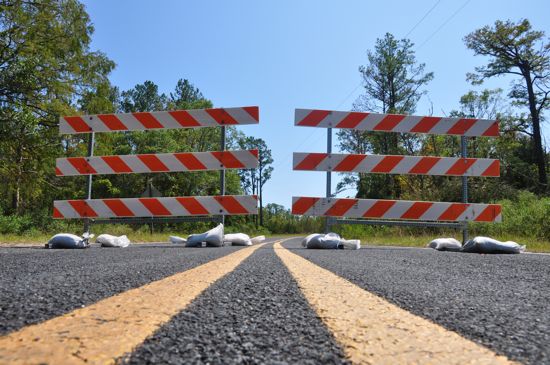 Can’t get there from here. Brown Creek Road is not navigable right now. A road block has been set up just past the intersection with Straight Road. You can still take a left off of Straight Road, but not a right. Travelers from Oriental wanting to get to Point Marina in Whortonsville or the communities along Brown Creek Road have to take the long way around. It’s three miles instead of one and a half.
Can’t get there from here. Brown Creek Road is not navigable right now. A road block has been set up just past the intersection with Straight Road. You can still take a left off of Straight Road, but not a right. Travelers from Oriental wanting to get to Point Marina in Whortonsville or the communities along Brown Creek Road have to take the long way around. It’s three miles instead of one and a half.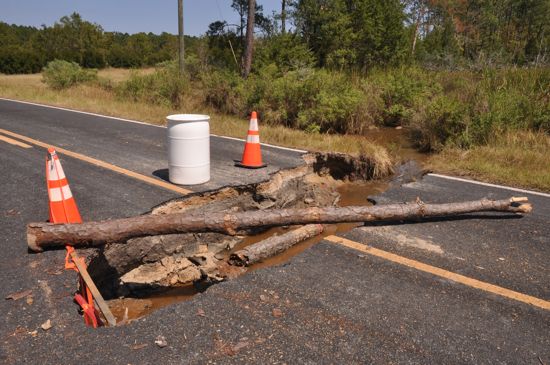 The cause of the road block. Three-quarters of the width of the road caved in after Hurricane Irene. Until it’s fixed, this is causing a detour of about 4 miles.
The cause of the road block. Three-quarters of the width of the road caved in after Hurricane Irene. Until it’s fixed, this is causing a detour of about 4 miles.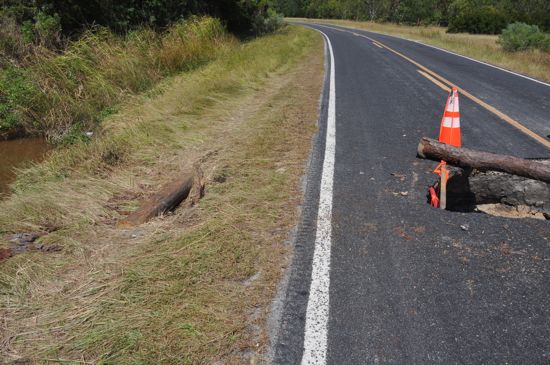 Some have not been patient about waiting for the road to be fixed. The going is dicey. The shoulder of the road is very soft, despite the addition of a pine log. Moments before this photo was taken a compact car got stuck trying to pass on the grass, and it required some sideways rocking of the car to get free.
Some have not been patient about waiting for the road to be fixed. The going is dicey. The shoulder of the road is very soft, despite the addition of a pine log. Moments before this photo was taken a compact car got stuck trying to pass on the grass, and it required some sideways rocking of the car to get free.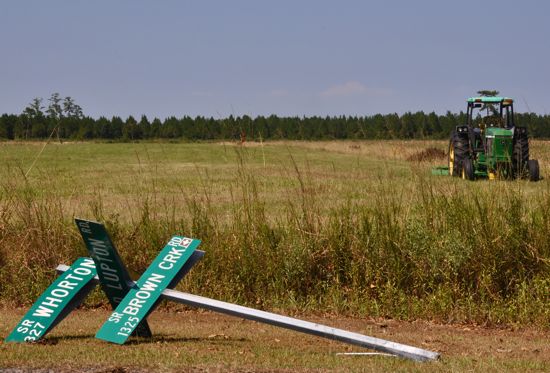 The road sign at Whortonsville and Lupton Roads.
The road sign at Whortonsville and Lupton Roads.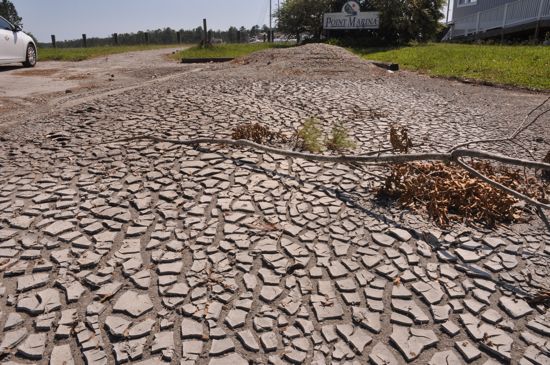 First flood, then desert like appearances. Stepping out of the car at Point Marina a week after Irene, the ground crackled under foot. .
First flood, then desert like appearances. Stepping out of the car at Point Marina a week after Irene, the ground crackled under foot. .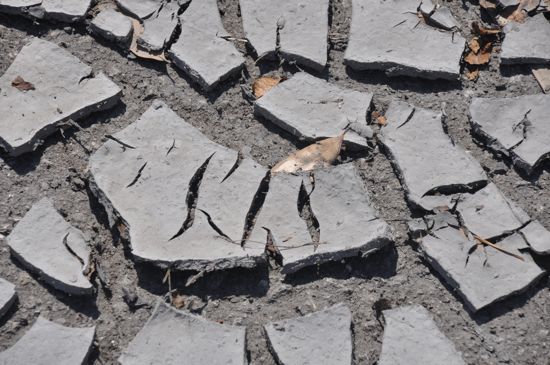 .
.